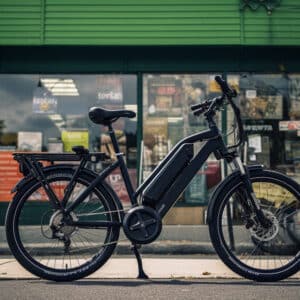Lithium-Ion Battery Fires: Causes, Risks, and Preventive Measures
Last updated Saturday, October 26th, 2024

Learn How to Safely Handle Lithium-Ion Battery Fires
Lithium-ion battery fires have more than doubled over the last five years. Insurance companies have confirmed a massive increase in five-figure claims related to battery fires.
Most of them are lucky enough to even file a claim after being involved in an accident like that. Why? Because electric battery fires and explosions usually cause devastating injuries or fatalities if you don’t clear the scene safely.
The eye-opening Bronx fire incident is a perfect example of just how dangerous these accidents can be. A single e-bike battery pack was identified as the cause of unprecedented damage in a Bronx supermarket. It destroyed a large section of the supermarket and injured nine people.
This incident along with several others put the spotlight on Lithium-ion battery safety once again. As manufacturers and regulators try to fix this issue, you must do your part as a consumer. Lithium-ion batteries are perfectly safe when used and maintained correctly. And you play a great role in ensuring that.
In this article, we’ll understand the causes and risks of Li-ion battery fires and explosions. We’ll also share a detailed guide to safely use and store them to avoid these accidents completely.
Understanding Lithium-Ion Battery Fires
What makes Li-ion battery fires so aggressive and difficult to control? It’s because of their high charge density and multiple flammable components. Each Li-ion cell has a small volume that packs a lot more power.
On one hand, it makes them super lightweight and portable. But when it explodes, it does so with much more force.
And it’s not just one cell that gets taken out. A Li-ion battery pack contains one or multiple cells. So one damaged cell will start a chain reaction to take out all the other cells too, multiplying the explosive force. It can lead to the battery temperature soaring above 932 degrees Fahrenheit within a few seconds.
Getting into firefighting mode right away is not going to help either. The intensity of the blaze is too high initially and there’s a high risk of an explosion engulfing the area around the battery. The bigger your battery size, the higher the risk of an intense fire.
Electric fires cannot be extinguished by water or standard fire extinguishers. They can release a lot of toxic fumes that shouldn’t be inhaled by anyone around the accident scene.
Causes of Rising Occurrence
Nearly all lithium battery fires are caused by short circuits.
A short circuit happens when the electrical current flows through an unintended shorter path with minimal resistance. It leads to an electrical overload. Currents that are 20 to 50 times stronger than the battery’s design limitations overwhelm the cell. This triggers a massive rise in pressure and temperature inside it. As the chain reaction damages other cells, these high-pressure flammable gases cannot be contained anymore and explode with a lot of force.
A lot of times short circuits are just an electrical reaction to human action. What action would that be? Overcharging your Li-ion battery. Not all devices have a built-in failsafe to cut off the power supply after it reaches full power.
Not all manufacturers follow strict quality control measures and safety tests either. They often cut corners to save costs by using cheaper materials that wear out easily. A lot of electric battery fire incidents have been tied to cheap imported products that were not properly certified.
Exposing them to extreme temperatures and moisture is another shortcut to a short-circuiting incident. You must also take care to dispose of them safely once they’ve run out of juice or else they can cause a fire during garbage disposal.
Investigating the Bronx Fire Incident

Firefighters were at the scene within four minutes of the smoke alarm going off. However, it took the fire less than five minutes to burn down the supermarket and the laundromat store nearby.
Fortunately, there were no deaths. Seven people were treated for minor injuries and two people faced severe injuries.
The FDNY Commissioner reported that the battery explosion caused the roof to cave in. She cautioned e-bike users to stick to UL-certified battery packs instead of sourcing unregulated products.
A lot of such incidents have been blamed on battery packs with unreliable certifications.
A single battery pack ended up burning down a massive supermarket. Imagine how much damage it could do to your home if something goes wrong.
The Widespread Use of Lithium-Ion Batteries
Lithium-ion batteries have played one of the biggest roles in the evolution of modern gadgets. Gone are the days of bulky and short-lasting electronics. They’ve been replaced by long-lasting sleek and lightweight gadgets.
They offer a significantly better performance and energy storage capacity compared to other battery types. That’s why you can find them in a variety of electronics ranging from laptops, smartphones, electric toothbrushes, vaping pens, e-bikes, and many more.
But it’s important to know the full spectrum of its advantages and disadvantages to become a conscious consumer.
Let’s start with the biggest benefits offered by Lithium-ion batteries:
- Cost-effective – The widespread acceptance of Li-ion batteries as the global standard for a variety of devices has pushed manufacturers to invest a lot of resources to upgrade them. Their mass production and long-lasting capacity have made them a highly economical option. Prices have dropped by more than 89 percent in the last 10 years.
- Longer battery life – Lithium-ion batteries have the longest lifespans compared to their competitors. A Li-ion battery can be used efficiently for at least 300-500 charge cycles, which means it can last for two to three years.
- High portability – Lithium-ion cells can store a lot of energy in a small volume. It allows manufacturers to make their devices more lightweight and portable.
- Low maintenance – Requires minimal maintenance procedures. You only need to replace it after a long period once it crosses its maximum charge cycles.
- Steady voltage – Each Li-ion cell can generate around 3.6 volts. These batteries can provide a steady voltage even if there is heavy usage.
Here are some of the key disadvantages of using Lithium-ion batteries:
- Vulnerable to impact – Lithium-ion batteries need to be encased in a durable case for their protection. Direct impact can easily perforate the liquid polymerized electrolytes and cause a fire or explosion.
- Requires charging supervision – Overcharging or overusing your Li-ion battery can trigger battery fires and explosions too. You also need protection circuitry to maintain the current within safe limits.
- Vulnerable to extreme temperatures – Exposing your battery to extreme heat, cold, or moisture can rapidly damage them and compromise your safety.
The Risks Posed by Lithium-Ion Batteries
Overcharging or physical damage can make lithium-ion batteries a little too hot for comfort. Even a small damaged Li-ion battery pack can produce a chain reaction that raises the temperature to 1500 degrees Fahrenheit. This chain reaction is known as thermal runaway, which creates a high-pressure breakout of flammable gases. It can trigger a violent explosion or an aggressive electric fire.
You could suffer severe burns or even lose your life if you’re actively using your device when this accident happens. Additionally, Li-ion battery fires and explosions can release a lot of toxic fumes, which can poison you and your environment even with mild exposure.
Despite these challenges, Lithium-ion batteries continue to be the gold standard in modern battery technology. Yes, there are contenders like solid-state batteries, solid-ion batteries, Zinc batteries, and lithium iron phosphate batteries.
Many of them offer better safety features, but their cost and energy efficiency still don’t justify them as viable alternatives. Li-ion batteries with upgraded safety and regulation standards seem to be the most suitable path for the industry in the near future.
Preventive Measures and Safety Guidelines
You need to be cautious with evolving technology, especially when the consequences of carelessness can be so devastating.
Here are some essential preventive measures and safety guidelines you must follow to prevent battery fires and explosions:
- Stick to buying devices with a UL-certified Lithium-ion battery (look for a prominent “UL” mark within a circle)
- Read the user’s guide provided by the manufacturer and follow all the instructions
- Use only the charging equipment provided by the manufacturer
- Do not modify the default battery stack without consulting the manufacturer
- Disconnect the charger once your Li-ion battery is fully charged
- Wait for at least 30 minutes to charge your e-bike after a long ride to prevent overheating damage
- Only charge one device battery at a time to avoid overloading the circuit
- Don’t charge the batteries when the temperature falls below 32°F or goes above 105°F
- Keep the batteries away from direct sunlight and moisture
- Keep them away from exit doors to have a quick route of escape available in case a battery fire breaks out
- Identify a local battery recycling service to safely dispose of your Li-ion battery
- Choose a reputable mechanic to get any repair work done
Addressing Manufacturer Issues

Another reason why regulatory agencies overlook e-bike safety is that most of these products are literally out of their sight. 80 percent of e-bikes, charging equipment, and batteries are manufactured in China. Some manufacturers enforce UL-certified batteries. But there are also plenty of them who cut production costs and compromise quality.
You must only purchase products that meet global quality control standards. It’s the best you can do till these products evolve to become safer and stronger regulations kick in to improve manufacturing safety.
Right now, there are hardly any federal and state laws to protect consumers from uncertified batteries and e-bikes in America. The Import Security and Fairness Act, which is currently being reviewed, is a step toward changing that. Another bill was introduced to direct the Consumer Product Safety Commission to establish a definitive safety standard for e-bikes and e-scooters.
Policymakers are also pushing cool tax incentives to encourage consumers to buy reliable Li-ion batteries. For instance, consumers who purchase UL-certified batteries will be able to get tax credits. Governments are also investing in the expansion of safe charging infrastructure for e-bikes and e-scooters.
Emerging Battery Technologies
What is the fastest, cheapest, and safest way to solve a problem? That is a question driving product development in every field.
When a product checks all three requirements, it marks a breakthrough moment in the industry. It becomes a global standard over time, just like Lithium-ion batteries in the field of battery technology.
A lot of industry experts speculate that there’s still a lot of room for improvement in Li-ion batteries and they will continue to dominate for many more years. However, there are promising developments in the field of battery technology that may be making headlines in a few years. Perhaps one of them may even succeed in minimizing the issue of e-bike battery fires.
Here are some promising alternatives to Lithium-ion batteries you must watch out for:
- Sodium-ion batteries – Their battery mechanism is almost exactly like lithium-ion batteries, but they use salt water as an electrolyte. They have a low energy density and can only store two-thirds of the amount of energy stored by Li-ion batteries. However, they have a low risk of battery fires.
- Iron-air batteries – These batteries oxidize iron to generate energy. They offer 25 times more storage capacity than Li-ion batteries and are highly affordable. However, their huge size and slow recharge time make them impractical for most devices.
- Zinc-based batteries – They discharge Zinc ions from the anode to the cathode instead of Lithium ions. Their low rate of self-discharge makes them viable for storing solar energy. They can store a huge amount of energy, but they do suffer from some short-circuiting issues currently.
- Lithium-sulfur batteries – They are considered to be more efficient than Li-ion batteries, boosting their range and energy storage. They may also reduce production costs by 25 percent. However, they are prone to corrosion and need to be replaced more often than Li-ion batteries.
- Solid-state batteries – They use a solid electrolyte instead of a liquid or gel. These batteries pack more power than Li-ion batteries and offer better efficiency. They may also last seven times longer than Li-ion batteries and won’t prove to be a fire risk due to the solid electrolyte. The biggest challenge faced by solid-state battery manufacturers is scaling up their testing and production capabilities.
Lithium-ion batteries have a high energy density. They store a lot of energy in a small body full of flammable components. When a cell is damaged, it leads to a sudden rise in pressure and temperature that releases flammable gases. The biggest safety check mark you should tick off while buying lithium-ion battery products is to ensure they are UL-certified. Look for a prominent “UL” logo inside a circle on the battery product. You can also verify its status with the battery manufacturer. Here are some important precautions to take while charging lithium-ion devices: Most lithium-ion batteries are well-enclosed within the body of smartphones and laptops. On one hand, it protects them from the environment. But you may not be able to see the wear and tear your battery is going through. It could be swelling up for months due to impact damage or overheating issues and suddenly trigger a battery fire or explosion. Out of all the emerging battery technologies, solid-state batteries are primed to become their biggest competitor over the next few years. They pack more power and offer seven times more energy storage than Li-ion batteries. Also, they don’t suffer from any fire safety issues because of their solid electrolyte. Frequently Asked Questions
What causes lithium-ion battery fires to be so explosive?
It begins a chain reaction that instantly takes out all the other cells in the battery pack too. The combined release of energy produces a violent explosion or an aggressive fire to break out that causes a lot of damage.How can consumers identify safer lithium-ion battery products?
Are there any precautions to take while charging lithium-ion devices?
What are the potential risks of using lithium-ion batteries in smartphones and laptops?
How do emerging battery technologies compare to lithium-ion batteries in terms of safety?











